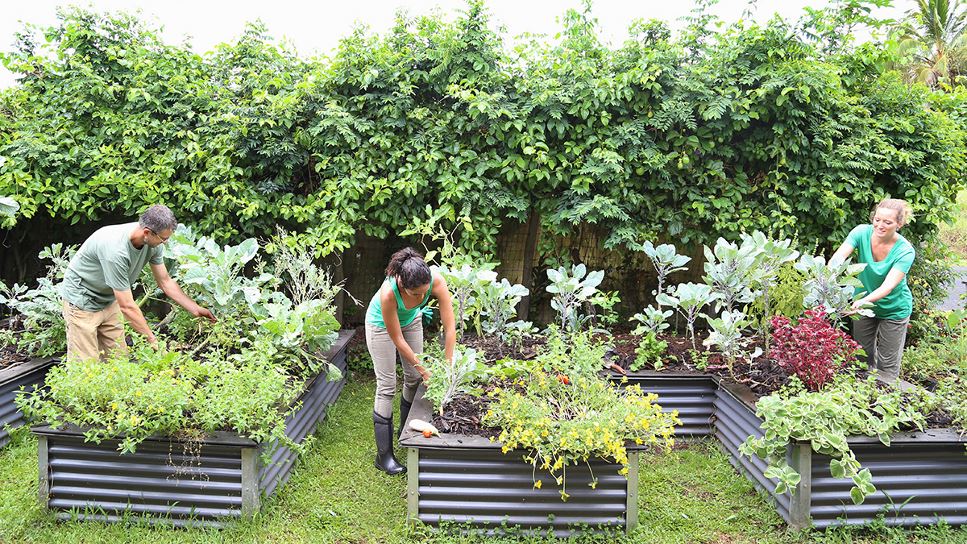According to the National Gardening Association’s 2023 survey, the onset of inflation led more people to become involved with community gardens, which help people save money by allowing them to grow their own fruits, vegetables and herbs. A community garden is a parcel of land that is gardened by a group of people individually or collectively. The land is usually divided into plots where each gardener is responsible for cultivating the plants that belong to them on their individual plot.
A community garden also offers the opportunity to give back by donating a portion of the harvest to local soup kitchens, food banks and food pantries. In 2021, more than 34 million Americans, including more than 9 million children, needed to utilize food programs that address food insecurity because they could not afford to purchase the food they needed. Community gardens can help to fill this need.
Interested in joining a local community garden? The American Community Gardening Association is a grassroots nonprofit advocacy organization linked to 2,100 community gardens across Canada and the United States. They aim to “build community by increasing and enhancing community gardening and greening.”
The Extension Master Gardener program has supported community gardens since 1972, making it one of the largest volunteer organizations in the country with more than 86,076 volunteers in all 50 states, plus several Canadian provinces and South Korea. Learn how to become a volunteer of your local Extension Master Gardener program.
Want to start a neighborhood community garden? Begin by consulting resources such as the University of Georgia Cooperative Extension, which recommends the following steps:
- Have a plan and determine if enough people are interested in having a community garden. You will need at least three to five people to be part of the planning committee. Make sure to establish community garden rules about maintaining plots. These rules should factor in the size or demand of the garden and guide gardeners on what is expected of them.
- Consider how you will fund the community garden. While collecting dues is one way to support the garden, many community gardens are now seeking sponsors. Sponsoring organizations may help by providing land or tools and assistance with liability insurance. Some community garden committees are becoming nonprofit organizations that accept donations and apply for funding grants. The U.S. Department of Agriculture has funding resources that can help you start and grow your community garden.
- Decide the types of plants the community garden members will grow. Having this information will help to narrow the search for the perfect location. If the community garden committee wants to grow food, finding a place that provides at least six hours of direct sunlight daily with easy access to a safe water source is vital. Check if the land has proper drainage for food to grow. Find out who the landowner of this site is and contact them about using the land — and whether buying or leasing it are options.
- Research the history and past uses of the site. Once the past uses have been determined, take samples of the soil and have them analyzed for soil type and quality. Consult with your state's environmental agency, local health department or county's cooperative extension office on how to take a soil sample and determine what types of samples you need based on the land’s history. This step provides information that may influence the design or location of your community garden.
Before you start planting, it is important to get rid of any weeds and hard clay soil. Then, bring in compost (also known as “black gold”), which consists of materials such as leaves, shredded twigs and kitchen scraps from plants. It is referred to as “black gold” because of the natural organic compost benefits it offers in improving soil structure, boosting nutrients in the soil, and attracting earthworms and beneficial insects to prevent infestation. Compost is a valuable and accessible soil enhancer that saves community gardeners money. It improves the physical conditions of the soil, reducing compaction and improving root growth and water-retention capacity. Organic composting is perfect for the community garden and reduces the amount of materials going to landfills.
The best plants to bring to your community garden are not those sold in the local garden center or seed catalogs, but those found in community gardens — cuttings or seeds of established plants. Cuttings are used to form new roots and stems to become a complete, independent plant. Your neighborhood community garden can organize a plant swap event, encouraging others to share their favorite plant cuttings and seeds. You also can share cuttings of one of your favorite landscapes or houseplants with neighbors in the community.
The benefits of community gardens are vast. Participating in a community garden can provide neighbors with an opportunity to connect one-on-one and help people living with food insecurity, while promoting sustainable agriculture by reducing negative environmental impacts, such as minimizing food transportation. Community gardens create habitats and can improve the conservation of the land area.
Now get out, meet your neighbors and make a difference in your community garden!
References
Find a Nutrition Expert
Looking for credible nutrition information and recommendations? The Academy of Nutrition and Dietetics' network of credentialed food and nutrition practitioners are ready to help!

